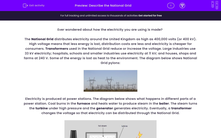Ever wondered about how the electricity you are using is made?
The National Grid distributes electricity around the United Kingdom as high as 400,000 volts (or 400 kV). High voltage means that less energy is lost, distribution costs are less and electricity is cheaper for consumers. Transformers used in the National Grid reduce or increase the voltage. Large industries use 33 kV electricity; hospitals, schools and smaller industries use electricity at 11 kV; and houses, shops and farms at 240 V. Some of the energy is lost as heat to the environment. The diagram below shows National Grid pylons:
.jpg)
Electricity is produced at power stations. The diagram below shows what happens in different parts of a power station. Coal burns in the furnace and heats water to produce steam in the boiler. The steam turns the turbine under high pressure and the generator generates electricity. Eventually, a transformer changes the voltage so that electricity can be distributed through the National Grid.
.jpg)
Now it's your turn to think about how electricity is generated and distributed.








